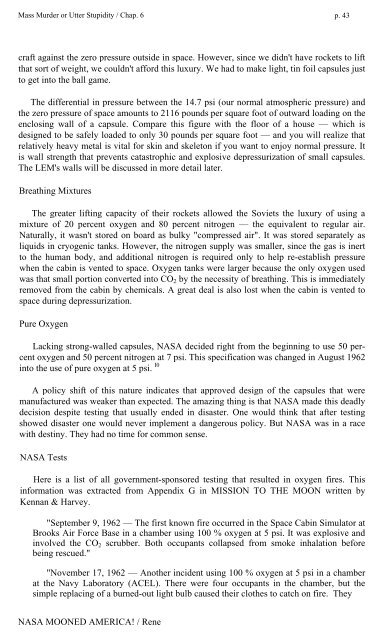Rene-NASA-Mooned-America
Rene-NASA-Mooned-America
Rene-NASA-Mooned-America
You also want an ePaper? Increase the reach of your titles
YUMPU automatically turns print PDFs into web optimized ePapers that Google loves.
Mass Murder or Utter Stupidity / Chap. 6 p. 43<br />
craft against the zero pressure outside in space. However, since we didn't have rockets to lift<br />
that sort of weight, we couldn't afford this luxury. We had to make light, tin foil capsules just<br />
to get into the ball game.<br />
The differential in pressure between the 14.7 psi (our normal atmospheric pressure) and<br />
the zero pressure of space amounts to 2116 pounds per square foot of outward loading on the<br />
enclosing wall of a capsule. Compare this figure with the floor of a house — which is<br />
designed to be safely loaded to only 30 pounds per square foot — and you will realize that<br />
relatively heavy metal is vital for skin and skeleton if you want to enjoy normal pressure. It<br />
is wall strength that prevents catastrophic and explosive depressurization of small capsules.<br />
The LEM's walls will be discussed in more detail later.<br />
Breathing Mixtures<br />
The greater lifting capacity of their rockets allowed the Soviets the luxury of using a<br />
mixture of 20 percent oxygen and 80 percent nitrogen — the equivalent to regular air.<br />
Naturally, it wasn't stored on board as bulky "compressed air". It was stored separately as<br />
liquids in cryogenic tanks. However, the nitrogen supply was smaller, since the gas is inert<br />
to the human body, and additional nitrogen is required only to help re-establish pressure<br />
when the cabin is vented to space. Oxygen tanks were larger because the only oxygen used<br />
was that small portion converted into CO 2 by the necessity of breathing. This is immediately<br />
removed from the cabin by chemicals. A great deal is also lost when the cabin is vented to<br />
space during depressurization.<br />
Pure Oxygen<br />
Lacking strong-walled capsules, <strong>NASA</strong> decided right from the beginning to use 50 percent<br />
oxygen and 50 percent nitrogen at 7 psi. This specification was changed in August 1962<br />
into the use of pure oxygen at 5 psi. I0<br />
A policy shift of this nature indicates that approved design of the capsules that were<br />
manufactured was weaker than expected. The amazing thing is that <strong>NASA</strong> made this deadly<br />
decision despite testing that usually ended in disaster. One would think that after testing<br />
showed disaster one would never implement a dangerous policy. But <strong>NASA</strong> was in a race<br />
with destiny. They had no time for common sense.<br />
<strong>NASA</strong> Tests<br />
Here is a list of all government-sponsored testing that resulted in oxygen fires. This<br />
information was extracted from Appendix G in MISSION TO THE MOON written by<br />
Kennan & Harvey.<br />
"September 9, 1962 — The first known fire occurred in the Space Cabin Simulator at<br />
Brooks Air Force Base in a chamber using 100 % oxygen at 5 psi. It was explosive and<br />
involved the CO 2 scrubber. Both occupants collapsed from smoke inhalation before<br />
being rescued."<br />
"November 17, 1962 — Another incident using 100 % oxygen at 5 psi in a chamber<br />
at the Navy Laboratory (ACEL). There were four occupants in the chamber, but the<br />
simple replacing of a burned-out light bulb caused their clothes to catch on fire. They<br />
<strong>NASA</strong> MOONED AMERICA! / <strong>Rene</strong>


